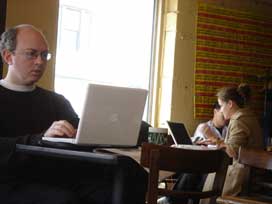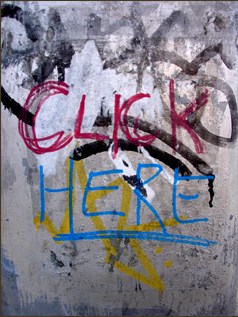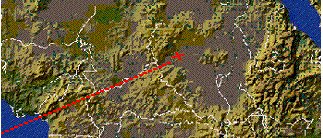In ten years, the world wide web has become an indispensable fact of life. Where do we take it next? At the conference’s closing plenary session, Peter Lunenfeld asked a similar question: “What is the next big dream that will keep us going? Are we out of ideas?” He then offered something called “urban computing” as a possible answer.
Here is my attempt (rather long, I apologize) to jump on that dream…
I live in New York, and in the past few years I’ve observed a transformation. My neighborhood coffee shop looks like an advertisement for Apple. At any given time, no less than two thirds of the customers are glued to their laptops, with mugs of coffee steaming in perilous proximity.  Power cords snake among the tables and plug into strips deployed around the cafe floor. Go to the counter and they’ll be happy to give you a dog-eared business card bearing the password to their wireless network. Of course, people have been toting around notebook computers since they first became available in the mid-80s, and they’ve certainly been no stranger to coffee shops. But with the introduction of Wi-Fi people are flocking in droves. Some kind of exodus has begun.
Power cords snake among the tables and plug into strips deployed around the cafe floor. Go to the counter and they’ll be happy to give you a dog-eared business card bearing the password to their wireless network. Of course, people have been toting around notebook computers since they first became available in the mid-80s, and they’ve certainly been no stranger to coffee shops. But with the introduction of Wi-Fi people are flocking in droves. Some kind of exodus has begun.
It’s a familiar sight throughout the more cosmopolitan neighborhoods of the city. Go to any Starbucks on the Upper West Side and you’re competing with half a dozen other customers for a space on their too-few powerstrips. And their Wi-Fi service isn’t even free. And come spring, I predict the same will occur in the city’s parks, especially those downtown, which are rapidly being integrated into a massive wireless infrastructure. No single entity is responsible for this, rather a lattice of different initiatives working toward a common goal: free high speed Wi-Fi coverage across Manhattan.
Mobile web and messaging technologies have already created a new breed of roving web users. Cell phones, PDAs, text messaging, Blue Tooth, RSS, podcasting (the list goes on..) have swept into our daily life like a tidal wave. More and more, we’re able to read, search, capture, edit, and send on the go, and with satellite-fed positioning technologies, we can pinpoint our location at any given time. What we have is the beginnings of a kind of “augmented reality” where information relates intimately to place, and vice versa. The world itself can now be as searchable, linkable, and informative as the web – a synthesis, or overlay, of real and virtual realities.
So the next big dream could be the evolution of the web into something more than a desktop system – into something that we can use while moving, and interact with anywhere.
Imagine an entire city redesigned as a communication platform. This has recently become a hot emerging field of research: “urban computing”, or “locative media”. It has also entered the choppy waters of urban planning. In his talk at the conference, New York sociologist and Silicon Alley chronicler Michael Indergaard, spoke of developers in lower Manhattan hoping to recast the hobbled financial district as a high-tech place “to work and play” – a weave of communications and public space. Given the tangle of ego, money and politics that has converged on Ground Zero, it’s hard to predict how this will pan out.. (for examples of recent initiatives, Downtown Alliance, Spectropolis). Or witness the hotly debated proposal to make the entire city of Philadelphia into one giant Wi-Fi hotspot.
Ultimately, the idea is to overlay the complex of buildings, streets and public spaces – the entire fabric of urban life – with the interconnectivity of the web. The implications for culture are as enormous as they are for business. Cities have always been the most brilliant cultural dynamos. Take the simplest, most essential urban act – walking through town – and you will discover a rich attendant tradition: from the eternal stroller, the flaneur, to the urban dérive, or drift, “a technique of rapid passage through varied ambiances,” as expostulated by the French Situationalists of the 1960s, most notably Guy-Ernest Debord. Or take the traditions of buskering, street photography, or the countless films that employ the city as canvas (take, for example, Woody Allen, who time and again has used the geography and rhythm of Manhattan in his neurotic self-portraits).  And let’s not forget what is probably the greatest literary treatment of consciousness in the modern city: Joyce’s Ulysses. In each case, the city is interpreted as a matrix of “psychogeographies” (to borrow again from the Situationalists) for which the amble, the stroll, the idle on the stoop, are the most effective tools of discovery (see earlier post City Chromosomes – An SMS Chronicle). The city is also the realm of chance: a kind of particle accelerator of circumstance that whips up coincidences with adrenalizing rapidity. It’s not hard to see how this is similar to our movements in virtual space – surfing, browsing, chatting, searching, stumbling upon newness – and how these two ways of movement could act in concert when computers are unmoored from desks.
And let’s not forget what is probably the greatest literary treatment of consciousness in the modern city: Joyce’s Ulysses. In each case, the city is interpreted as a matrix of “psychogeographies” (to borrow again from the Situationalists) for which the amble, the stroll, the idle on the stoop, are the most effective tools of discovery (see earlier post City Chromosomes – An SMS Chronicle). The city is also the realm of chance: a kind of particle accelerator of circumstance that whips up coincidences with adrenalizing rapidity. It’s not hard to see how this is similar to our movements in virtual space – surfing, browsing, chatting, searching, stumbling upon newness – and how these two ways of movement could act in concert when computers are unmoored from desks.
The beginnings of this can be found at the intersection of photography and the web. Digital cameras and camera phones have become incredibly popular. People are snapping pictures everywhere they go, then sharing them through email, image messaging, or online image banking services like Ofoto or Flickr. New technologies are in the works that will allow people to plug in photos the same way they plug in keywords on a search engine, effectively asking “what am I looking at?” or “where have I seen this before?” (see earlier post, Hyperlinking the Eye of the Beholder). Amazon’s new yellow pages service allows you to see photos of the business your are looking for, and to virtually stroll, or scroll, down the block to get a sense of the surrounding environment (see earlier post, From Apsen to A9). A student project called “Grafedia” was presented recently at the Tisch ITP winter show which allows people to put “hyperlinks” in any physical environment. As described by its inventor John Geraci:
Grafedia is hyperlinked text, written by hand onto physical surfaces and linking to rich media content – images, video, sound files, and so forth. It can be written anywhere – on walls, in the streets, or in bathroom stalls. Grafedia can also be written in letters or postcards, on the body as tattoos, or anywhere you feel like putting it. Viewers “click” on these grafedia hyperlinks with their cell phones by sending a message addressed to the word + “@grafedia.net” to get the content behind the link.”
I can imagine Grafedia as a fun urban diversion – a trail of crumbs, a flirtation, a new way of marking territory – or even as a kind of x-ray vision into closed spaces. A discrete little tag could alert a passerby to shady goings-on within. Though primitive, these new technologies represent the seeds for new social practices, new ways of creating and sharing meaning.
And locative media need not be restricted to cities. GPS technology presents new possibilities for tracing a meaningful path through the physical world – global hide-and-seek, or more frightening, a means of surveillance.  A recreational pastime, “geocaching,” has already sprung up around this technology. In the game, which resembles a kind of global scavenger hunt, participants identify “caches” on the web and track them down with their GPS device. Caches are used as a kind of exchange for anything people might like to share – books, software, recipes, jewelry, clothing, art (anything, really) – and as a stop along the trail to other caches. Clearly, the thrill of finding, of tracking, is the main attraction here.
A recreational pastime, “geocaching,” has already sprung up around this technology. In the game, which resembles a kind of global scavenger hunt, participants identify “caches” on the web and track them down with their GPS device. Caches are used as a kind of exchange for anything people might like to share – books, software, recipes, jewelry, clothing, art (anything, really) – and as a stop along the trail to other caches. Clearly, the thrill of finding, of tracking, is the main attraction here.
Solitary roaming through nature could also, theoretically, be “plugged in” to the mobile web. One of the conference presenters, John Chris Jones, has for the past four years has been writing a peripatetic web journal beamed in from his Wordsworthian walks through the English countryside. I for one would find this to be a terrible intrusion into solitude, but I offer up the possibility without judgement, keeping in mind that Thoreau’s “isolated” cabin on Walden Pond was less than a mile from the train tracks.
In the end, societies and cultures work through presence – through people, things, and ideas interacting in the same environment. Far from stripping individual locales of their unique qualities, the web in its infant decade has enabled people to explore and converse like never before about their particular place in the world, while simultaneously connecting every point on the map – the realization of McLuhan’s “global village”. The next step, it would seem, is to shed the physical restrictions of desktop computing so the village can be explored on foot.
